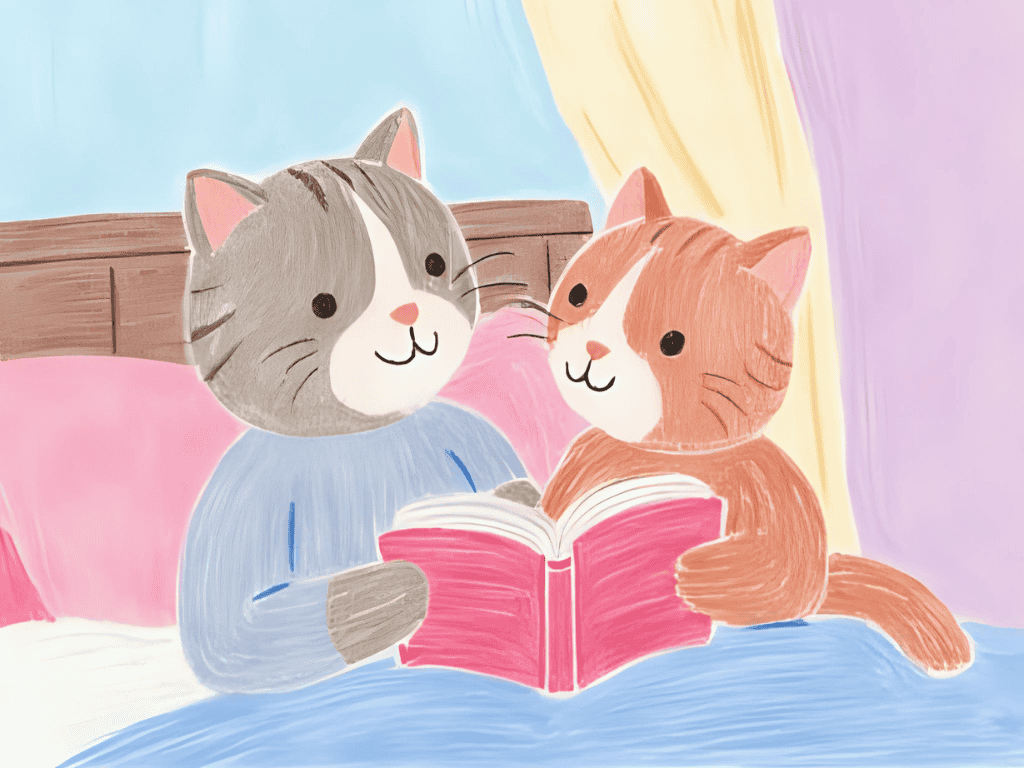Bedtime Stories For Kids – 3 Critical Ages to Start Reading
Bedtime stories for kids: Research consistently shows that children benefit from any reading of bedtime stories approach started consistently, with early readers (0-6 months) showing slightly stronger language development patterns, though children who begin later quickly catch up when routines are maintained consistently.

Understanding the Three Critical Windows for children’s bedtime stories
While some parents worry they’ve missed the “window” for optimal brain development, research shows that children benefit from bedtime stories for kids whether you start at birth, six months, or even as late as three years old – the key is choosing the right approach for your child’s current stage.
Whether your child is a newborn who seems to sleep through every word or a busy toddler who won’t sit still, there’s a proven approach that will work for your unique situation.
The Newborn Window (0-6 months): Building the Foundation
Easy Technique: Voice and Rhythm Focus
During the newborn stage, your baby can’t understand words or follow storylines, but their brain is rapidly developing neural pathways for language recognition. The simplest approach involves reading any book in a soft, rhythmic voice for 5-10 minutes before sleep. The content matters less than the consistency and calming tone.
Mid-Range Technique: Sensory Integration
Combine gentle reading of bedtime stories for kids with light touch, such as stroking your baby’s arm while reading, or choosing books with different textures for you to feel while reading aloud. This multi-sensory approach helps establish positive associations with books and story time.
Advanced Technique: Linguistic Pattern Building
Select books with strong rhythm and repetition, such as classic nursery rhymes or kids books with rhyming patterns. Research from the University of Washington shows that babies who hear rhythmic language patterns show enhanced brain activity in areas associated with language development.
- Voice recognition and bonding development
- Establishing sleep routine foundations
- Language rhythm and pattern exposure
- Parental voice familiarity building
- Neural pathway formation for language
- Calm environment association creation
- Basic auditory processing development
- Routine consistency establishment
- Stress reduction through familiar sounds
- Early attachment strengthening
The Baby Window (6-18 months): Interactive Engagement
Easy Technique: Picture Pointing and Simple Words
As babies develop visual focus and begin to understand that pictures represent objects, point to images while saying simple words like “cat,” “moon,” or “sleep.” Books with large, clear pictures work best during this stage.
Mid-Range Technique: Responsive Reading
Pay attention to what captures your baby’s interest – if they reach for a particular page or babble at certain pictures, spend extra time on those elements. This responsive approach helps maintain engagement and teaches babies that their reactions matter.
Advanced Technique: Proto-Conversation Development
Use kids books as conversation starters, even though your baby can’t respond with words yet. Ask questions like “Do you see the kitty?” and pause for their response (babbling, pointing, or facial expressions), then respond as if they’ve answered. This technique builds the foundation for future reading comprehension and discussion skills.
- Visual tracking and picture recognition
- Interactive engagement beginning
- Cause-and-effect understanding
- Simple word recognition development
- Attention span gradual extension
- Social interaction through books
- Motor skill coordination (page turning)
- Object permanence reinforcement
- Memory pattern development
- Vocabulary foundation building
Welcome to the world of Bobby, Angie, and little Anya – a loving cat family in Manchester whose nightly lullabies hold the power to heal hearts, chase away fears, and inspire hope in even the darkest moments.
The Toddler Window (18+ months): Story Comprehension
Easy Technique: Simple Story Following
Choose kids books with clear beginning, middle, and end structures. Read the same bedtime books repeatedly, as toddlers learn through repetition and begin to anticipate story elements. This builds comprehension and memory skills.
Mid-Range Technique: Interactive Storytelling
Encourage participation by having your toddler fill in familiar words, make animal sounds, or point to objects you name. This active engagement improves attention span and makes reading a collaborative activity rather than passive listening.
Advanced Technique: Comprehension and Extension
After reading bedtime story for kids, ask simple questions about the story, relate story elements to your child’s life (“The little bear went to sleep just like you!”), and encourage predictions about what might happen next. This develops critical thinking and comprehension skills.
- Story comprehension emergence
- Active participation and responses
- Narrative structure understanding
- Character identification and empathy
- Predictive thinking development
- Language expression encouragement
- Critical thinking skill foundations
- Emotional regulation through stories
- Independent choice-making introduction
- Complex vocabulary acquisition
Remember that every family’s journey with bedtime stories looks different, and what works for your neighbor’s child might need adjustment for yours. Start with the approach that feels manageable for your current life situation, and trust that consistency matters more than complexity. The investment you make in reading today creates benefits that will last your child’s entire lifetime.
Your child’s relationship with books begins with your willingness to start, not with finding the perfect moment. Tonight could be the first night of a beautiful tradition that shapes your child’s love of learning forever with simple sleep tight stories.
Let these adorable baby kittens inspire kindness, creativity, and countless hours of peaceful coloring fun. Join the Pet Babies Show family and discover the magic of mindful creativity!

The Best Time to Start Reading Bedtime Stories: Tips and Tricks
The best time to start reading bedtime stories for kids in english to your child is exactly when you’re reading this article – right now. Whether your child is a newborn, baby, or toddler, there’s a proven approach that will work for your family’s current situation. The magic isn’t in perfect timing; it’s in the consistent commitment to sharing stories, building connections, and creating positive associations with reading.
Start immediately (any age works)
- Begin with 5-10 minutes nightly
- Choose simple, repetitive books
- Focus on consistency over perfection
- Adapt to your child’s attention span
Never too late: Benefits occur immediately
- 0-6 months: Voice bonding
- 6-18 months: Interactive engagement
- 18+ months: Story comprehension
Starting with books too advanced for age
- Inconsistent timing and routine
- Forcing attention when child isn’t ready
- Comparing your child to others
- Giving up after initial resistance
Child anticipates story time
- Increased attention span over time
- Requests favorite books repeatedly
- Shows interest in pictures or words
- Calmer transition to sleep
Don’t Wait for the Perfect Moment
Don’t wait for the perfect moment, the perfect book, or the perfect response from your child. The perfect time to start reading bedtime stories for kids is now, with whatever books you have, and however much time you can consistently commit. Your future self and your child will thank you for beginning today.
Winners announced the first week of the following month. Good luck, families!
Is it really beneficial to read to a newborn who doesn’t seem to respond?
Absolutely. Newborns are absorbing language patterns, rhythm, and vocal tone even when they appear unresponsive. Brain imaging studies show that newborns’ language centers activate during story time, building neural pathways that support future language development.
How do I know if my baby is too young for bedtime stories?
There’s no such thing as too young for bedtime stories. Even premature babies benefit from hearing their parents’ voices. Adjust your expectations rather than your timing – focus on bonding and routine rather than comprehension for very young babies.
What if my toddler won’t sit still for stories?
This is completely normal. Try shorter books, more interactive stories, or reading while your toddler plays quietly nearby. Some children need movement to focus, so don’t insist on perfect stillness. Consistency matters more than perfect attention.
Should I read the same books repeatedly or introduce new ones?
Both approaches have benefits. Repetition helps children learn language patterns and develop memory skills, while variety prevents boredom and exposes children to different vocabulary. A good balance is 70% familiar books and 30% new ones.
How long should bedtime story sessions last at different ages?
Newborns: 5-10 minutes, Babies (6-18 months): 10-15 minutes, Toddlers: 15-30 minutes. Follow your child’s attention span rather than strict time limits, and gradually increase duration as interest grows.
What if I miss several nights of reading due to illness or travel?
Missing occasional nights won’t undo the benefits of consistent reading. Resume the routine as soon as possible and don’t feel guilty about disruptions. The long-term pattern matters more than perfect daily consistency.
Should both parents read bedtime stories, or is one consistent reader better?
Both approaches work well. Having multiple readers exposes children to different voices and reading styles, while single readers can develop deeper routine consistency. Choose what works best for your family’s schedule and preferences.
How do I choose age-appropriate books for bedtime reading?
For newborns: rhythm and rhyme matter most. For babies: large, clear pictures and simple words. For toddlers: simple storylines with relatable characters. Trust your child’s attention span and interest level as guides.
Is it normal for children to have favorite books they want to hear repeatedly?
Very normal and beneficial. Repetition helps children internalize language patterns, predict story elements, and feel confident about their understanding. Honor their preferences while occasionally introducing new options.
What should I do if my child becomes upset or scared during story time?
Choose calmer books for bedtime, save exciting or potentially scary stories for daytime reading. If a child becomes upset, comfort them and switch to a familiar, soothing book. Build positive associations rather than pushing through distress.
How do I handle bedtime reading with multiple children of different ages?
Choose books that work for your youngest child’s attention span, then add discussion or activities for older children. Alternatively, stagger bedtimes so each child gets age-appropriate individual attention before group reading time.
How do I maintain bedtime reading routines during stressful periods or major life changes?
Simplify rather than eliminate the routine. Even reading one short book or singing a lullaby maintains the structure. During stressful times, familiar routines provide comfort and security for children.
Bedtime Stories for Kids Final Thoughts
The guilt many parents feel about starting “too late” or not doing “enough” often prevents them from beginning at all. Your child doesn’t need perfect execution or expensive books – they need your voice, your attention, and your commitment to showing up with a story every night. The benefits of this simple practice extend far beyond literacy development, creating emotional security, communication skills, and family bonds that influence your child’s entire life trajectory.



